Toshiba Regza 42Z3030D 42in LCD TV Review
Toshiba Regza 42Z3030D 42in LCD TV
Can Toshiba better its excellent X series TVs with the new high-end Z series?
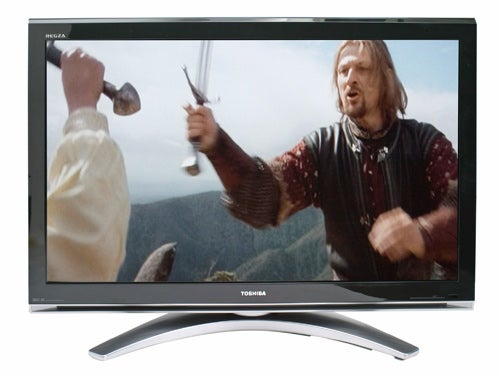
Verdict
Key Specifications
- Review Price: £1149.90
Over the past couple of years, Toshiba’s LCD TVs have come on in leaps and bounds. There was a time when the likes of Panasonic and Sony were the first names in consumers’ heads when it came to TVs, but these days you’d be a fool not to have Toshiba on your short list. This year though, Toshiba really pulled the stops out, with 1080p and HDMI 1.3 support on all but its entry level sets.
Back in may I reviewed the Toshiba Regza 42X3030D, which proved to be a superb performer, packed with features for an unbelievably low price. In fact, at first glance it seemed like Toshiba would have a tough time trying to sell its flagship model later in the year – the Z series. But Toshiba was smart enough to leave 100Hz processing off the X series feature list, so that the Z series would have a clear differentiator. 
The Z series features sizes ranging from 37in, all the way up to 57in, but it’s the 42in version that I’m looking at right now. This is probably still the most popular size in UK homes, offering enough real estate to be considered large, but not enough to dwarf the average living room. It also helps that 42in screens, even high-end ones like this, have become surprisingly affordable of late. So, despite the fact that this is Toshiba’s top-end 42in TV, you can already pick it up on the street for under £1,200.
It’s not just the price that’s attractive about the 42Z3030D though, this is also a very good looking TV. The undeniably stylish glossy black bezel is carried over from the 42X3030D that I reviewed previously, but the Z series also has a very cool looking speaker enclosure. Whereas the X series just had a standard speaker grille mounted below the screen, the Z series has a recessed cut-out that’s bordered with silver. Now, I usually don’t like to see sleek, glossy black lines broken up with silver, but in this case it really does look great. The trademark Toshiba crescent shaped stand is also in evidence, which also adds to the pleasing aesthetics, as well as providing smooth panning.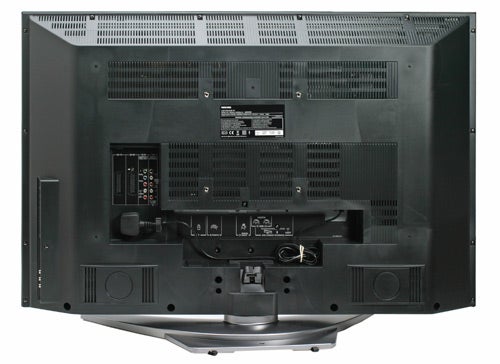
Unsurprisingly, the 42Z3030D is a full HD TV with a 1,920 x 1080p panel, and like its X series sibling, it can accept 1080p signals in 24, 50 and 60 flavours. Now, although 1080p 24 is arguably the holy grail of home movie watching, it doesn’t come without its own problems. The biggest problem is that of judder, where smooth pans tend to be anything but smooth, but Toshiba is well aware of this issue and attempted to counteract it with the Film Stabilisation setting. Unlike the 100Hz processing, which deals with images moving across the screen, Film Stabilisation specifically targets the potential judder issue associated with panning, and the good news is that it works very well.
Having already touched on the 100Hz nature of this TV, I may as well cover that next. It’s worth noting that the first TV with 100Hz processing to ever make it into the TrustedReviews lab was from Toshiba. About a year ago I reviewed the Toshiba 32WLT68, which was the first LCD TV I’d seen to incorporate 100Hz processing and it definitely made its presence felt, pretty much eliminating motion smear. Now however, 100Hz processing is common place in LCD TVs, so can Toshiba’s Active Vision M100 HD processing still keep up?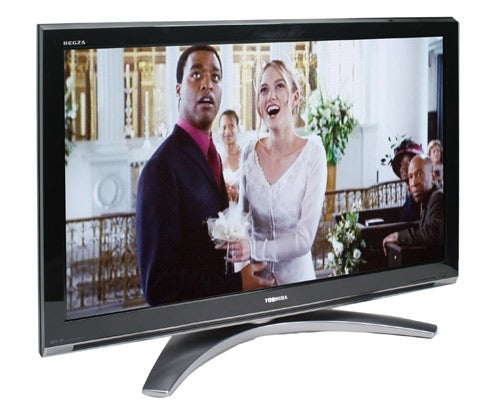
When it comes to smooth motion, the 42Z3030D definitely excels, and the common loss of resolution when objects are moving across the screen on LCD screens simply isn’t there on this TV. In fact, when you’re watching a clean HD source, it’s staggering how much detail this Toshiba manages to resolve, no matter how much movement and action there is. But superb as the 100Hz processing is when watching HD content, it brings with it a few side effects when watching an SD source.
If you’re watching an SD source, such as the built-in digital tuner, the 100Hz processing does some rather unpleasant things to the picture. First and foremost are some horrible shimmering effects around edges, especially around peoples’ faces on close-ups. There’s also an exacerbation of the shimmering that affects parallel lines on an image, like blinds or fences. Turning off the 100Hz when watching standard definition definitely improves matters, but strangely the image quality from the integrated tuner on the 42Z3030D just doesn’t seem to be as good as that seen on the lower-end 42X3030D. 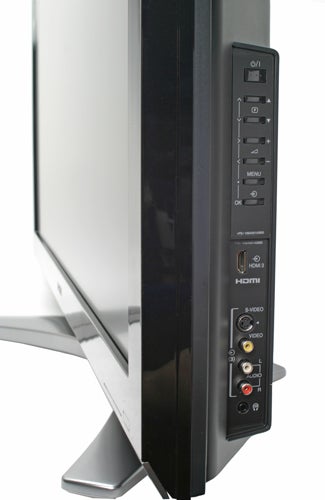
Unfortunately it’s not just the built-in tuner that highlights the 42Z3030D’s weakness with SD content. As a side by side comparison, I fired up The Bourne Identity on both HD DVD and on standard DVD – obviously the HD DVD version looked superbly sharp, but the DVD version looked worse than I had expected it to. I found myself having to make a choice – if I left 100Hz processing on, I got far better resolution of moving subjects, especially in fast moving scenes like the awesome car chase, but I also ended up with terrible shimmering effects around edges. The other choice was to turn 100Hz off to dispel most of the shimmering, but then put up with slightly blurred moving images.
So surprised was I by the poor SD performance on the 42Z3030D that I requested another sample from Toshiba, fearing that there was actually a problem with my original TV. Firing up the new model instantly confirmed my suspicions, with SD looking far cleaner, both with and without 100Hz processing enabled. The replacement 42Z3030D even managed to produce decent images from the integrated Freeview tuner, which is notoriously difficult for any TV with a Full HD panel. Put simply, when viewing the replacement unit, all of the above issues simply weren’t there.
If you are the type of buyer who intends to feed their high-end TV with a steady diet of high-quality HD content, then you definitely won’t be disappointed with the 42Z3030D. Any Michael Bay blockbuster will give a TV a good run for its money, but his latest effort, Transformers, is a great test for any HDTV. This is probably one of the best HD DVD discs to hit the market, with near seamless integration of live action and CGI, even under the high definition magnifying glass. The bright desert scenes looked suitably bleached, but not at the detriment of detail – every grain of sand is beautifully resolved by the 42Z3030D. And the scene where Mikaela checks under Bumble Bee’s hood is, quite simply, stunning!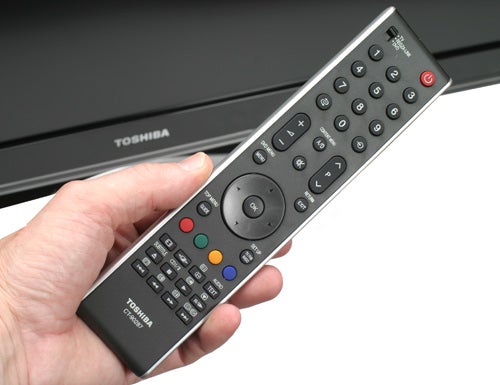
Of course it comes as no surprise that Transformers looked amazing. I was playing the disc on a Toshiba HD-XE1 that was outputting a 1080p 24 signal. The 42Z3030D accepts a 1080p 24 signal and applies a 5:5 pull down technique. This means that you’re essentially getting a 120Hz image, with each of the 24 frames repeated five times. Of course with 5:5 pull down in play, you don’t need to be applying 100Hz processing, in order to create composite frames, since you’ve actually got real frames to play with. As such, when the 42Z3030D detects a 1080p 24Hz input, it disables the 100Hz processing, even if it is selected under the menu.
Toshiba quotes a 10,000:1 contrast ratio for the 42Z3030D, but of course this is a result of dynamic backlight technology, whereby the brightness of the backlight is determined by the scene being viewed. Although this technology can yield impressive results, it can, on occasion, be distracting, when the brightness is dropped back for a dark scene. Thankfully I wasn’t able to ascertain a drop in backlight intensity while watching the 42Z3030D, but then I was also not overly impressed with the general black level performance either. The 42Z3030D tends to produce very dark grey, rather than solid blacks – although, on the plus side, you don’t tend to lose detail in low light areas of a scene. Also, my review unit exhibited slight light bleed from the bottom of the screen, which was highlighted when watching a widescreen movie with the TV running its Exact Scan 1:1 pixel mapped setting. Again, this problem didn’t seem quite as bad on the replacement unit though.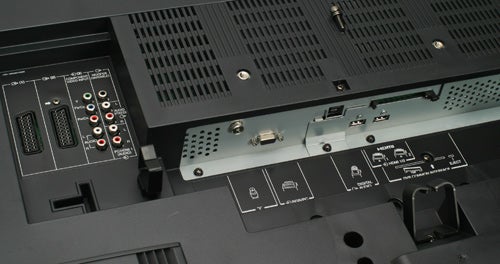
When it comes to connectivity the 42Z3030D doesn’t disappoint. You get three HDMI 1.3 ports for digital HD sources. I usually mention that the HDMI 1.3 standard supports the Deep Colour, high bit depth feature that will hopefully appear on discs in the not too distant future, but this is the first TV I’ve seen that actually has a Deep Colour setting under the menu. Interestingly, there’s also an xvYCC setting under the menu, for enabling an extended colour gamut – this is somewhat surprising, since the xvYCC colour space usually requires LED backlighting technology, whereas this TV uses the more common cold cathode light source.
You also get a set of component video connections for analogue HD sources, and unlike some TVs, the 42Z3030D is happy to accept a 1080p signal over component as well as HDMI. There are also two SCART sockets, a D-SUB port, S-Video, composite and analogue audio inputs. You also get analogue audio output, a subwoofer output and an optical digital output for passing through the digital audio from an HDMI source. Finally there’s a CI slot for adding subscription services to the integrated digital tuner.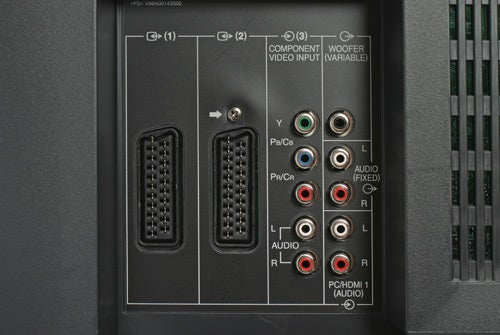
Often when a manufacturer tries to make a design feature out of a TV’s speaker enclosure, the sound quality suffers. Thankfully that doesn’t appear to be the case with the 42Z3030D, which produces a pretty convincing sound stage. Obviously big explosions are a little weak compared to a dedicated surround sound setup, but on the whole there’s enough bass on hand to draw you into even the most over-the-top action fest – did I mention Transformers?
If you’re thinking of buying the Toshiba 42Z3030D, my advice would be to purchase from a retailer that has a solid returns policy, because if your TV turns out like the first sample I looked at, you’re going to want to send it straight back. The good news though, is that if you get a good example, you’ll get superb performance on HD and equally impressive results on standard definition fodder.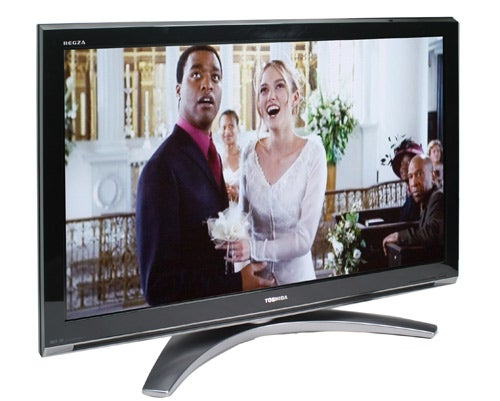
”’Verdict”’
I’m glad that I requested a second review sample of the 42Z3030D, because the conclusion of this review would have been very different if I hadn’t. I’m not sure what was wrong with the initial model that Toshiba sent me, but I can only hope that it was an early sample and that the replacement is indicative of what customers will receive.
Going by the performance of the second unit, the 42Z3030D is a superb high definition TV that’s stuffed to the brim with features. If you feed it a high-quality 1080p 24Hz signal, it will reward you with superb picture quality, stuffed with impressive detail resolution. The only weak link is the slightly disappointing black levels, but if black levels are your main concern, you should be looking at Plasma and not LCD anyway.
The big question is whether the 42Z3030D is worth the £350 premium over the excellent Toshiba 42X3030D, and ultimately the answer is yes. You’re getting an extra HDMI port, 100Hz processing, xvYCC wide colour gamut, Deep Colour support and a more stylish design. And you’ll be safe in the knowledge that this TV sits at the top of the Toshiba tree.
”’Update”’
Having heard from several readers who have suffered similar problems to those that I saw in my initial review sample, I have dropped the scores on this TV and consequently removed its Recommended award. It appears that the very poor standard definition performance exhibited by the first 42Z3030D I saw wasn’t a “one off” problem after all. I shall be talking to Toshiba directly in an attempt to find out how these issues with it’s flagship TV range occurred.
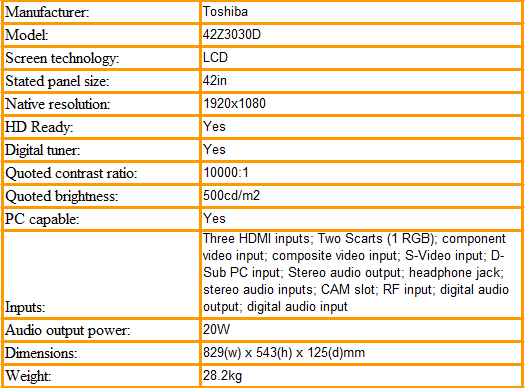
How we test televisions
We test every TV we review thoroughly over an extended period of time. We use industry standard tests to compare features properly. We’ll always tell you what we find. We never, ever, accept money to review a product.
Trusted Score
Score in detail
-
Value 8
-
Image Quality 8
-
Sound Quality 8

